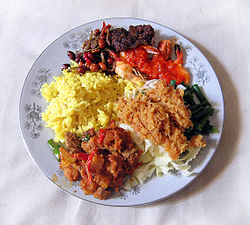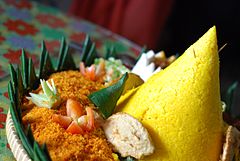Nasi kuning
 Nasi kuning personal serving, surrounded with rich Indonesian dishes | |
| Course | Main course |
|---|---|
| Place of origin | Indonesia |
| Region or state | Nationwide in Indonesia |
| Created by | Javanese |
| Serving temperature | Hot and room temperature |
| Main ingredients | Rice cooked in turmeric surrounded with side dishes |

Nasi kuning (Indonesian for: "yellow rice"), or sometimes called nasi kunyit (Indonesian for: "turmeric rice"), is an Indonesian fragrant rice dish cooked with coconut milk and turmeric,[1][2] hence the name nasi kuning (yellow rice).
Cultural significance
In Indonesian culture, nasi kuning has favorable symbolic meanings. The yellow-colored rice is perceived to looks like a pile of gold, so it is often served in festive occasions; including parties, housewarmings, welcoming guests and opening ceremonies — as a symbol of good fortune, prosperity, wealth and dignity.[3]
Nasi kuning is quite widespread and commonly found in Indonesian culture. It can be found from Java to Sumatra, Bali and Sulawesi. However, it is most strongly associated with Javanese and Minahasa traditions. In Java, nasi kuning might come in the form of a cone called a tumpeng and is usually eaten during special events. The top of the tumpeng is customarily given to the most senior person in attendance. One of the most popular nasi kuning variant is came from Manado of North Sulawesi, which employs cakalang (skipjack tuna).[4]
Ingredients and serving
The addition of turmeric and coconut milk, sometimes also includes pandan and lemongrass during the rice cooking and steaming process, has contributed to a tempting colour, pleasant fragrance, soft texture and a flavourful taste of the yellow rice.
Nasi kuning is usually served with a variety of side dishes such as shredded omelette, serundeng (relish of grated coconut and spices), urap (vegetable in shredded coconut dressing), teri kacang (fried anchovy and peanuts), sambal goreng (fried tempeh and potato caramelized in spicy sauce), ayam goreng (Javanese-style fried chicken), balado udang (shrimp in chilli), or perkedel (potato fritters). More elaborate nasi kuning might include fried cow's brain, fried cow's lung, beef and seafood. It is common to serve nasi kuning with kerupuk udang (shrimp cracker) or emping chips and a decoratively cut cucumber and tomato.
See also
- List of rice dishes
- Nasi bogana
- Nasi campur
- Nasi goreng
- Nasi kucing
- Nasi lemak
- Nasi liwet
- Nasi pecel
- Nasi tim
- Nasi uduk
- Nasi ulam
 Food portal
Food portal
References
- ^ Helen Agostino, Kathy Kiting, Asia Education Foundation, Indonesia Kaleidoscop, Curriculum Corporation, 1999, 59p. ISBN 1-86366-383-5
- ^ Heinz Von Holzen, Wendy Hutton, Lother Arsana, The Food of Indonesia Tuttle Publishing, 1999, Page 62 ISBN 962-593-389-1
- ^ "Nasi Kuning Recipe (Indonesian Yellow Fragrant Rice)". Indonesia Eats.
- ^ Maya Safira (26 April 2016). "Nasi Kuning Manado yang Sedap dengan Pelengkap Ikan Cakalang". detikFood (in Indonesian).
